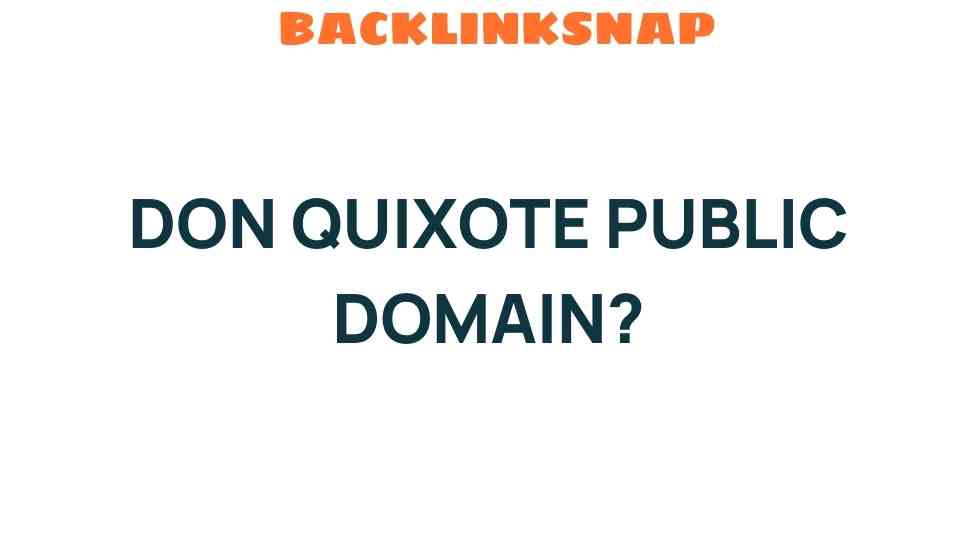Is Don Quixote Public Domain? Unraveling Literary Legacies
When we think of classic literature, few works resonate as profoundly as Don Quixote by Miguel de Cervantes. This monumental novel, often hailed as one of the first modern novels, has enchanted readers for centuries with its rich narrative and complex characters. Yet, an intriguing question arises: is Don Quixote in the public domain? Understanding the status of this literary masterpiece not only illuminates Cervantes’ legacy but also provides insights into copyright, intellectual property, and the broader landscape of literary history.
The Public Domain Explained
Before delving into the specifics of Don Quixote, it’s essential to clarify what public domain means. Works in the public domain are free from copyright restrictions, allowing anyone to use, modify, and distribute them without seeking permission or paying royalties. This status can arise from various factors, including the expiration of copyright, government works, or voluntary relinquishment of rights.
Copyright and Literary History
The concept of copyright, particularly in the realm of literature, has evolved significantly over the centuries. In Cervantes’ time, copyright was virtually nonexistent in the way we understand it today. Don Quixote was published in two parts: the first in 1605 and the second in 1615. Importantly, both editions were released long before the establishment of modern copyright law, which began to take shape in the 18th century with the Statute of Anne in 1710 in England.
Is Don Quixote Public Domain?
Absolutely! Don Quixote, having been published over 400 years ago, is firmly in the public domain. This status is due to the fact that copyright typically lasts for the life of the author plus a set number of years (usually 70 years in many jurisdictions). Since Cervantes passed away in 1616, the work’s copyright has long since expired. As a result, anyone can freely access and reproduce Don Quixote, contributing to its ongoing relevance in the literary world.
The Impact of Public Domain on Literature
The public domain status of Don Quixote has had profound implications for literature and cultural heritage. Here are several ways it enriches our literary landscape:
- Accessibility: With Don Quixote in the public domain, countless adaptations, translations, and interpretations are available to a global audience. This accessibility fosters greater understanding and appreciation of Cervantes’ work.
- Creative Inspiration: Artists, writers, and filmmakers draw inspiration from Don Quixote, leading to innovative reinterpretations that keep the spirit of the original alive while bringing new perspectives to light.
- Academic Exploration: Scholars and students can engage with the text without restrictions, leading to deeper analysis and discussions surrounding its themes, characters, and impact on literature.
Cervantes’ influence on literature is immeasurable. His ability to weave humor with profound philosophical insights has inspired countless authors across various genres. The character of Don Quixote, with his idealism and folly, continues to symbolize the struggle between reality and imagination. This duality resonates with readers, prompting reflection on their own lives, dreams, and societal norms.
Modern Adaptations and Their Significance
In the public domain, Don Quixote has spurred a myriad of adaptations across different media:
- Literature: Numerous authors have reimagined Cervantes’ tale, exploring themes of chivalry and madness in new contexts.
- Film and Theatre: From animated features to serious dramas, filmmakers have found rich material in Cervantes’ narrative, showcasing its timeless appeal.
- Visual Art: Artists have used the iconic imagery of Don Quixote and his companion Sancho Panza to comment on contemporary societal issues.
FAQs About Don Quixote and Public Domain
1. Why is Don Quixote considered a classic?
Don Quixote is celebrated for its innovative narrative structure, complex characters, and exploration of themes such as reality versus illusion, making it a cornerstone of modern literature.
2. When was Don Quixote published?
The first part of Don Quixote was published in 1605, followed by the second part in 1615.
3. What does it mean for a work to be in the public domain?
A work in the public domain can be freely used, modified, and distributed without permission or payment, as it is no longer protected by copyright.
4. Can I legally adapt Don Quixote?
Yes! Since Don Quixote is in the public domain, you can create adaptations, translations, and derivative works without seeking permission.
5. How has Don Quixote influenced modern literature?
Don Quixote has inspired countless authors and artists, influencing narrative techniques and themes that address the human condition, identity, and the nature of reality.
6. Where can I find free versions of Don Quixote?
You can find free versions of Don Quixote online at various platforms, including Project Gutenberg (Project Gutenberg) and many other digital libraries.
Conclusion
In summary, Don Quixote is not just a literary masterpiece; it is a beacon of creativity that remains vibrant and relevant in today’s cultural landscape. Its public domain status allows for an expansive dialogue about Cervantes’ work, enabling adaptations and scholarly pursuits that keep the spirit of the original alive. As we continue to explore the depths of literary history, the legacy of Cervantes and Don Quixote will undoubtedly inspire future generations. As readers and creators, we are fortunate to partake in this rich tapestry of human expression, forever shaped by the enduring vision of one of literature’s greatest figures.
This article is in the category Digital Marketing and created by BacklinkSnap Team




